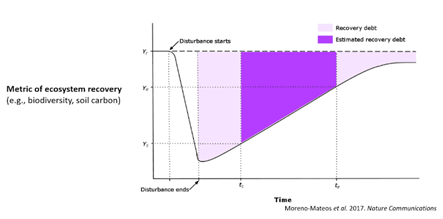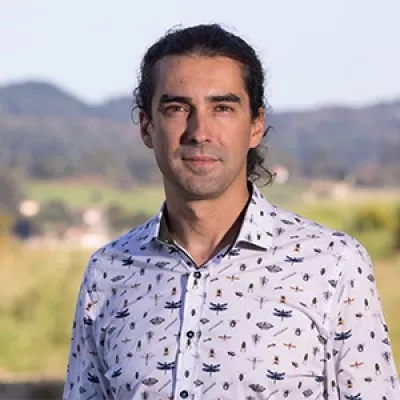Dr David Moreno-Mateos
Associate Professor in Physical Geography
Tutorial Fellow at St Edmund Hall, Oxford
Associate Professor in Physical Geography
Tutorial Fellow at St Edmund Hall, Oxford
Academic Profile
David Moreno-Mateos is an Associate Professor in Physical Geography and Tutorial Fellow at St Edmund Hall. He is also an Ikerbasque Research Professor at the Basque Center for Climate Change - BC3 in the Basque Country, Spain. His main focus is the long-term recovery of ecosystems degraded by human development in the context of global change. He is interested in estimating how long it takes for ecosystems to recover their less resilient attributes, like the interactions among soil organisms and plants. Understanding this allows us finding tools to increase the currently limited performance of ecosystem restoration. To do so, he investigates local scale recovery patterns using meta-analysis, but also uses empirical approaches to understand how the structure of species interactions and the deriving functionality re-assemble over the long term. He works on areas being degraded by ancient human activities, mostly agriculture, and abandoned centuries ago. Some of these field sites are the Norse farms of South-west Greenland, where former hayfields have been recovering from ancient agriculture for >650 years, or the Pre-Columbian agricultural areas of the Central Amazon, recovering for up to 2,000 years.
He is interested in bringing this ecological knowledge to the practice of ecosystem restoration through technological solutions. With this approach, restored ecosystems may be able to reach a high functionality, resilience and adaptability to ongoing global changes faster
David got his PhD from the Spanish National Research Council (CSIC) and the University of Alcala, both in Spain, with honors in 2008. He then got postdoctoral fellowships at the University of California at Berkeley, Stanford University and the Centre National de la Recherché Scientific (CNRS) in France. He has been awarded an Ikerbasque fellowship from the Basque Country government and a Ramon y Cajal fellowship from the Government of Spain to join the Basque Center for Climate Change - BC3, where he is now a Research Professor (part time). Before joining Oxford, he was Assistant Professor at Harvard University. David have authored >50 papers in scientific journals and books, including papers in Nature Communications, Nature, PLOS Biology, or Nature Ecology and Evolution. He has been, or currently is, part of the editorial boards of Journal of Applied Ecology, Ecosystem Restoration, and Frontiers in Plant Conservation.
Current Research
The legacy of human disturbance
Human activities partially or totally degrade ecosystems, making them less diverse, less functional and more vulnerable to further change. For years, we have been quantifying the effects of disturbance on ecosystem diversity and function, but less has been known about the effects of disturbance on their recovery. One may think that thanks to the restoration of degraded ecosystems and to increasing ecological engineering and design (e.g., nature based solutions, green infrastructure), we can bring back lost biodiversity and functions, and even justify further degradation.
But, can we actually restore ecosystems? For several years, studies have tried to respond to this question by estimating how much biodiversity and ecosystem functions and services are recovered thanks to restoration efforts. Results have been controversial but it seems that on average ecosystems recover, but three major questions remain unanswered: To what extent? How do we measure ecosystem change? And, how long does it take?
To respond to these questions, we have performed a series of meta-analysis including thousands of ecosystems undergoing recovery from anthropogenic disturbances globally (Figure 1). We have found that recovering ecosystems are less diverse and functional, and host less dense populations than undisturbed ecosystems. We are trying to understand now when they would host similar attributes to undisturbed ecosystems, if they ever do it. These bring up other questions, are restored ecosystems commonly entering alternative stable states? Are these states as resilient as the undisturbed ones? Would they ever reach similar states to those existing in the predisturbance state in terms of stability or resilience?

Meta-analysis and other analytical reviews are extraordinary tools to find patterns of ecosystem recovery, but not to understand mechanisms that may be useful for decision makers, land managers, practitioners, ecological engineers or designers to support their decisions based on hundreds of cases. However, restoration and ecological engineering and design require a deeper insight in the local environment of each particular project, and this is why we also work to understand those mechanisms.
The long-term recovery of ecosystem complexity
One of the most relevant questions in restoration ecology is to estimate the magnitude of anthropogenic disturbance, that is, what would it take for an ecosystem to fully recover? A common problem to respond to this question is to choose how to quantify disturbance or recovery. With present knowledge and technology, it is still not possible to measure a whole ecosystem. However, several proxies that partially reflect the complexity of ecosystems have been used, and these include interaction networks. What is less clear is how the reassembly of interactions drives the functional recovery (and to some extent also vice versa). Studies are starting to show that the structure and stability of interaction networks strengthen as recovery proceeds. How and when a state of dynamic stability is reached, how it is affecting the resilience of the system to further disturbance and how it can be engineered or facilitated are some of our specific goals.
Anthropogenic disturbances also affect other dimensions of ecosystem complexity, like the amount of genetic information contained in the system. Disturbance reduces genetic diversity and hence the evolutionary potential of species. Today, we can identify what regions have been lost and associate them with specific functions that may or may not be related to their evolutionary potential. We hypothesize that genomes whose genetic diversity has been reduced by direct or indirect human selection can recover after the end of the disturbance at the right timescale. We are interested in how the recovery process operates at "ecological scales." Experimental studies on ecosystem recovery or restoration involves periods of a few decades at the most. However, the recovery process of a whole ecosystem, including its populations and communities, in real world conditions requires time periods of several centuries or millennia according to peleoecological records (that do not deal well with interactions for now). Our fundamental goal is to combine complex metrics and long-time periods to reconstruct the re-assembly of the interaction-function structure and the genome-function structure of ecosystems after anthropogenic disturbances. Given the lack of long-term ecosystem measurement of any complex metric, we apply a space-for-time substitution approach and use chronosequences.
A critical challenge that we need to address is how climate change is affecting the recovery process in a way that outcomes may differ from pre-industrial times. We are addressing this challenge in two ways. First, by synchronizing chronosequences with paleolimnological records and studying the response of ancient communities to past climate changes. Second, based on these past responses we can make projections on expected future communities resulting from the recovery process under proposed climate change scenarios.
We are currently working in three systems with this approach:
The first system is the ancient agricultural fields that the Norse created in Greenland. There are a few hundreds of Norse farms found by archeologists that have remained uninhabited from about 650 to 1050 years after the local population collapsed due to a convergence of social and environmental factors. Here we are looking into the reassembly of the interactions between the soil microbial community and the plant community, specifically the fungal and bacterial communities, and its effects on the carbon and nitrogen pathways.
The second system is the ancient agricultural areas that the Pre-columbian people created and used for millennia in the Amazon. In this system, again archaeologists have identified thousands of sites and many of them have remained uninhabited. After the Spanish Conquer and driven by slavery and European diseases, a large proportion of these peoples disappeared and left millions of hectares abandoned. All this land has become one of the oldest and largest secondary growth forests in the word. Here we are looking at the genomic recovery of the Brazil nut (Bertholletia excelsa). Indigenous peoples selected and dispersed this species through the Amazon. We are looking at the genomic recovery of the Brazil nut and identifying the recovered functions to study their role in the resilience of the species to ongoing global changes. Over time, we will expand this approach to a community level.
The third system is the current temperate forest in North-eastern US that is recovering on former agricultural fields. After the arrival of the European settlers to the regions, they almost completely clear cut the forest that was previously exploited by indigenous peoples. Given the limited quality of the regional soils for agriculture, most of the forest was abandoned and have been naturally recovering over the last 140 to almost 200 years. In this system, we are using the same approach detailed on the Greenland system but this time we are focusing on the tree community.
Teaching and Advising
Teaching
David teaches section in the Environmental System Processes, Geographical Controversies and Environmental System Dynamics. He also teaching the module on Ecosystem Restoration in the MSc in Biodiversity Conservation and Management.
Current doctoral students
| Alvaro Moreno Martin | The recovery of interactions and function in post-agricultural Norse Greenland. |
| Vanessa Harden | Designing the Fungal City. Co-supervised with Gary Hilderbrand (Harvard University) |
Recent doctoral students
| Asun Rodriguez Uña | Recovering hte stability of interaction networks in temperate forests affected by mining since the Middle Ages. Currently, Newton International Fellow at the University of Cambridge. |
Selected Publications
For a complete list of publications, please visit his website, Google Scholar, or ResearchGate.





